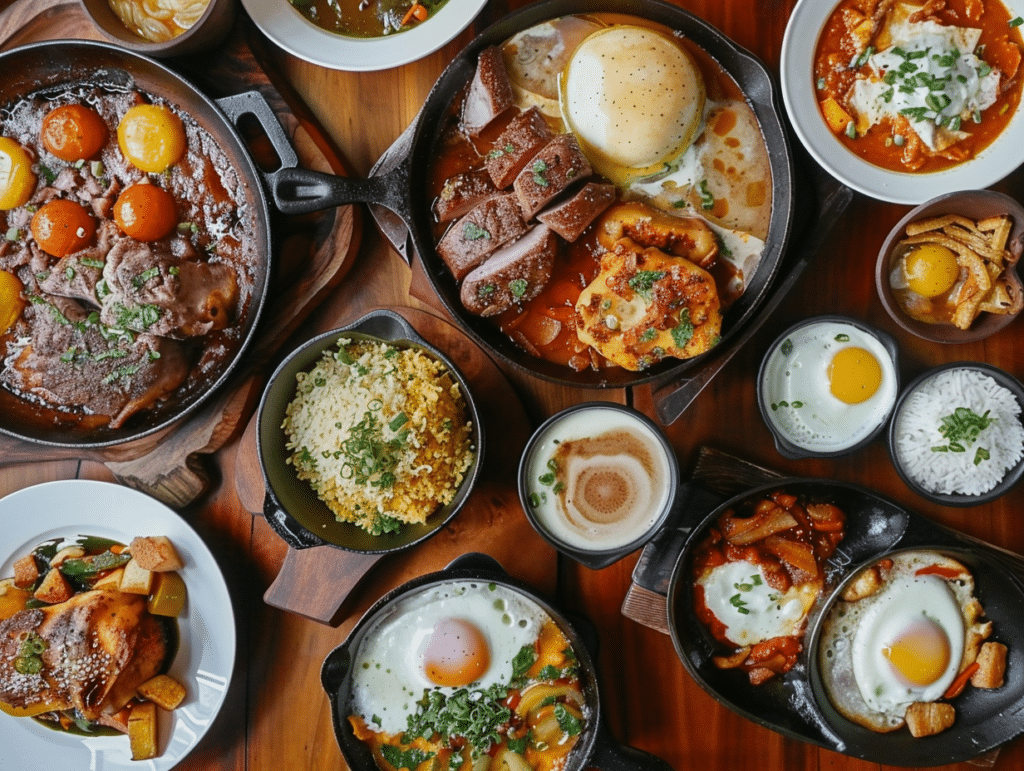Menü

Filipino food and German food represent two distinct culinary traditions with contrasting flavors, ingredients, and cooking techniques. Let’s delve into the key differences between the two:
1. Flavors and Ingredients:
– Filipino food is known for its bold and vibrant flavors, often featuring a combination of sweet, sour, and savory notes. Common ingredients include rice, coconut milk, fish sauce, vinegar, garlic, and tropical fruits like mango and banana.
– German cuisine, on the other hand, tends to favor richer, heartier flavors. Pork, beef, and poultry are prominent proteins, while ingredients like potatoes, cabbage, sauerkraut, and various types of bread are staples. Herbs such as parsley, dill, and caraway seeds are commonly used for seasoning.
2. Cooking Techniques:
– Filipino cooking techniques often involve stewing, braising, and grilling. Dishes like Adobo (meat stewed in vinegar and soy sauce), Sinigang (sour soup), and Lechon (roast pig) showcase these methods.
– German cuisine frequently involves techniques such as roasting, braising, and sautéing. Classic German dishes like sauerbraten (marinated roast beef), schnitzel (breaded and fried meat cutlets), and bratwurst (sausages) highlight these cooking methods.
3. Regional Variation:
– Filipino cuisine varies significantly from region to region, reflecting the diverse landscapes and cultural influences across the archipelago. For example, coastal regions often feature seafood-heavy dishes, while mountainous areas may showcase hearty stews and vegetable-based dishes.
– German cuisine also exhibits regional diversity, with each region boasting its own specialties and culinary traditions. For instance, Bavarian cuisine is renowned for its hearty fare such as sausages, pretzels, and dumplings, while Northern Germany is known for dishes like Labskaus (corned beef hash) and Fischbrötchen (fish sandwiches).
4. Meal Structure:
– Filipino meals typically consist of rice as the main staple, accompanied by various viands (ulam) such as meat, fish, or vegetable dishes. Meals are often communal, with dishes served family-style.
– German meals often feature meat as the focal point, accompanied by potatoes, bread, or noodles. Traditional German dinners may include multiple courses, starting with soup or appetizers, followed by a main course and dessert.
In summary, Filipino food and German food offer contrasting culinary experiences characterized by different flavors, ingredients, cooking techniques, and meal structures. While Filipino cuisine embraces bold and diverse flavors with a focus on rice and tropical ingredients, German cuisine tends towards hearty, meat-centric dishes accompanied by potatoes and bread. Despite these differences, both cuisines showcase a rich culinary heritage that continues to delight food enthusiasts worldwide.
Interested in Filipino Food? At PinoyFood.de, we offer original Filipino products that will satisfy your taste buds. Visit our store in Siegen or buy from our online shop: https://pinoyfood.de/shop/
Siegtalstrasse 206
57080 Siegen-Niederschelden
0271 3878064
[email protected]
Alle hier genannten Preise verstehen sich inkl. der gesetzlich festgelegten MwSt. und zzgl. der gewählten Versandkosten. Die durchgestrichenen Preise entsprechen dem bisherigen Preis in diesem Online-Shop. Alle Markennamen, Warenzeichen sind Eigentum Ihrer rechtmäßigen Eigentümer und dienen hier nur der Beschreibung.